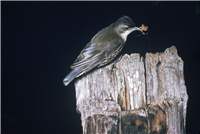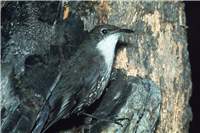Family
Climacteridae
Genus
Cormobates
Species
leucophaeus
Threats/Control Methods - Regional
Land clearing and habitat simplification pose the biggest threats to the species, as they depend heavily upon the forests and woodlands within and around the ACT. It is possible that as little as 3-4% of the original extent of the Yellow Box/Red Gum Grassy Woodland remains in something like its natural state.
Threats/Control Methods - Local
Introduced Common Mynas (Acridotheres tristis ) and Common Starlings (Sternus vulgaris) are more aggressive in securing nest hollows within the declining woodland habitat and throughout the suburbs.
Local/Urban Actions
The preservation of large areas of suitable woodland habitat is key to the survival of this species. Collecting firewood from nature reserves or national parks should not be undertaken, as this will impact on the important foraging resources. Gardeners can encourage the species by ensuring their yard consists of a good mix of trees, shrubs and ground litter. Cat owners can prevent their pets preying on the species by providing a stimulating indoor environment and by installing a cat run or enclosure.
Common Names
Little Treecreeper, Little White-throated Treecreeper, Woodpecker
Distinguishing Features
The White-throated Treecreeper is a fairly small bird at 13-15cm in size. It is a dark grey-brown colour overall, with a white throat and central underparts. The dark plumage under its wings is white-streaked and the rump has dark grey and white stripes. During flight a red patch is noticeable on the wings. The female has a distinctive orange spot on her white cheek.
Survey Techniques
Call and visual identification.
Species Call
A clear, ringing, musical 'whit-whit-whit' or a mellow 'twiet-twiet-twiet'.
Similar Species
The far less common Red-browed Treecreeper (Climacteris erythrops) is similar apart from its red face and brow and striped belly.
Distribution
This species is found across the eastern states of the Australian mainland, mostly in the mountainous forest areas of northern VIC and NSW. Within the Canberra region, its distribution is quite uneven, with the majority of birds in the northern and central suburbs and very few towards the Tuggeranong area.
Country of Origin
Australia
Conservation (Pet/Pest) Status - Regional
Population numbers vary from year to year, but overall it is stable (COG).
Conservation (Pet/Pest) Status - National
Secure, not listed under the EPBC Act 1999.
LSCCES Population
A high number of birds were recorded at ANBG and BMt, moderate numbers at CSIRO and BMP, and one at ANU.
Associated vegetation community
This species survives well in rainforest, eucalypt forest and woodland, and forested river corridors in dry climates.
Limiting Resources
The White-throated Treecreeper depends upon a forest or woodland resource with appropriate tree hollows in mature trees and a good mix of ground cover and shrubs. Aggressive introduced species such as Cats (Felis catus), Common Mynas (Acridotheres tristis ) or Common Starlings (Sternus vulgaris) also pose a threat.
Breeding
The female begins the breeding season activities with tree hollow inspections in early September. The nesting hollow is deep and narrow, found up to 20m above the ground. The hollow is lined with soft bark and grass and 2-4 cream and brown spotted eggs are laid. The female alone incubates for 22-23 days and the male feeds her during this time. The young spent 25 days in the nest. In good seasons, a pair will have two broods.
Behaviour
The White-throated Treecreeper spends most of its time foraging for insects in trees. They have a short, spiralling flight and can become very tame, roosting overnight on people's houses and clinging to the outside walls.
Functional Group
Food Species
This species eats mostly ants, but will sometimes eat other insects and some nectar.
Predators
Cats (Felis catus) may hunt this species. They must also compete for nest hollows with the Common Myna (Acridotheres tristis ) and the Common Starling (Sternus vulgaris), both introduced species.
Interesting Fact
All species of Treecreepers need the same sort of nesting hollows and are known to take turns using the same site from season to season.
References - (reader suitability of references, P=Primary teachers, S=Secondary students, T=Tertiary students and researchers)
Books:Freudenberger, D. 2001. Bush for the birds: Biodiversity enhancement guidelines for the Saltshaker Project, Boorowa, NSW. Consultancy report to Greening Australia ACT and SE NSW Inc. CSIRO Sustainable Ecosystems. Canberra. S, T
Morcombe, M. 2000. Field Guide to Australian Birds. Steve Parish Publishing. Archerfield. Australia P, S, T
Pizzey, G. 2000. The Graham Pizzey & Frank Knight Field Guide to the Birds of Australia. Angus & Robertson, Sydney. P, S, T
Veerman, P. 2003. Canberra Birds: A report on the first 21 years of the garden bird survey. Philip Veerman and Canberra Ornithologists Group. Canberra. S, T
Internet: Birds in Backyards. 2006. [online]. Available at:http://www.birdsinbackyards.net P, S, T
Canberra Ornithological Group (COG). 2004. Birds of Canberra Gardens. COG and the ACT Department of Urban Services. [online]. Available at:http://garden.canberrabirds.org.au/ P, S, T
Online Publications:ACT Government. 2004. Woodlands for Wildlife: ACT Lowland Woodland Conservation Strategy. Action Plan No. 27. Environment ACT, Canberra. [online]. Available at: http://www.environment.act.gov.au/nativeplantsandanimals/threatecspec/woodlandsstrategy S, T
Environment ACT. ACT Government. 2006. Action Plan No. 18: Brown Treecreeper. [online]. Available at:http://www.environment.act.gov.au/__data/assets/pdf_file/13567/actionplans18.pdf S, T
Nix, H. and Cunningham, R. 2006. Birds of the Lower Sullivans Creek Catchment, Canberra ACT. Prepared for the Life in the Suburbs project using data from the Lower Sullivans Creek Catchment Ecological Survey (LSCCES). Australian National University. Canberra. [online]. Available at: http://www.lifeinthesuburbs.com.au/category.php?id=65 S, T


 Top
Top Top
Top